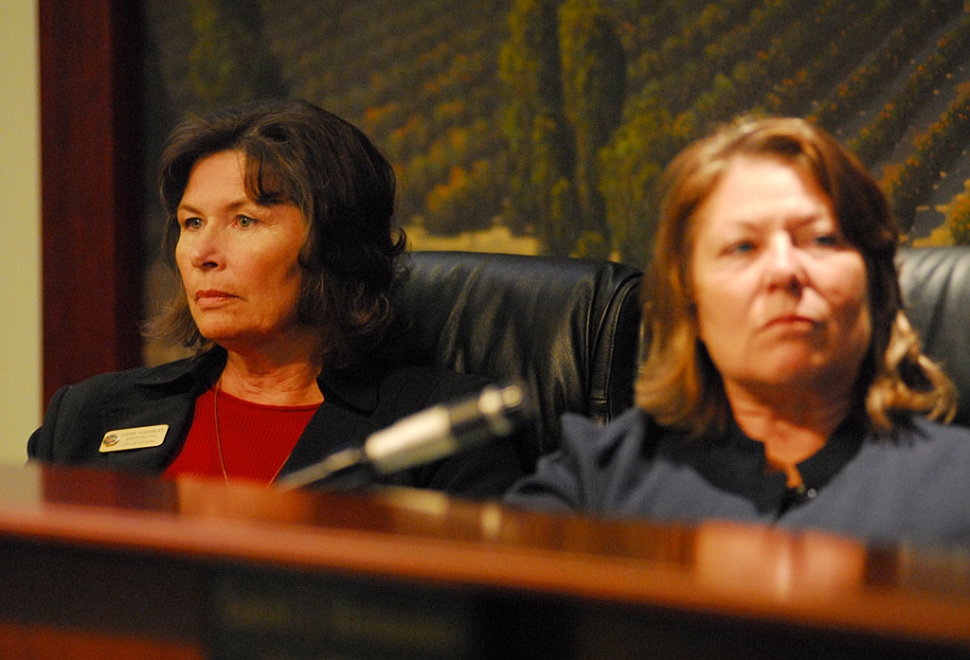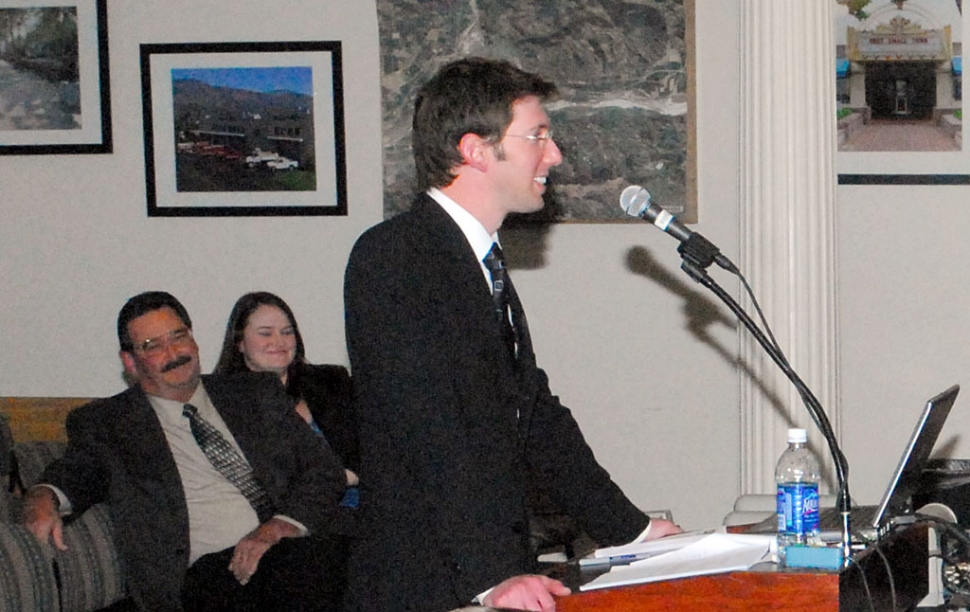|
Schneider leads Brown Act Workshop
 (l-r) Council Members Washburn and Walker watch the required Brown Act Workshop. By Wanda Castel de Oro — Wednesday, December 9th, 2009
 Fillmore City attorney Ted Schneider conducted a 90-minute Brown Act Workshop Tuesday night, instructing Council in the essentials of the law. The Workshop was part of the lawsuit settlement brought by Rich McKee, seated left with his attorney Kelly Aviles. Tuesday night’s City Council meeting was dominated by a 90 minute Brown Act Workshop, conducted by city attorney Theodore Schneider, in response to a lawsuit settlement brought by Rich McKee, of Californians Aware, for three times violating the Brown Act in August. The suit settled with the city admitting the council’s “errors”, a 2-hour Brown Act retraining, and payment of McKee’s attorney fees in the amount of $6,000. The matter was filed with the court by the City Attorney’s Office on November 16, 2009. On December 3, 2009 McKee sent a Brown Act Demand for Correction to the Fillmore City Council regarding an item on the November 24, 2009 Agenda concerning “Existing Litigation…Richard P McKee v. City of Fillmore; Ventura County Superior Court...” The same description remained when an amended agenda was posted on November 20, 2009. No such litigation existed on November 24, 2009. In his Demand, McKee sought two remedies at the December 8th council meeting: first, the council was to announce that it violated the Brown Act on November 24, 2009, by agendizing and holding a closed session pursuant to Government Code § 54956.9(a) – Existing Litigation, when in fact the litigation identified did not exist; and second, disclosure of the entire discussion had in that improperly held closed session. Kicking off the council meeting, Schneider announced the intent of the closed session and that the Demand letter was available for public view. Mayor Walker asked for any public comment, with all three steps fulfilling the Brown Act. Council went to closed session. Upon returning, Schneider explained the events of the meeting. He said Council directed him to give a letter to McKee, who was in the audience, stating that Council disagreed with his Demand. “To sum up the substance of our correspondence,” stated Schneider, “jurisdiction of the trial court still existed on November 24th.” McKee gave no response at that time. Following, Schneider began the Workshop by saying the Brown Act is “complicated and not always the most accessible to non-lawyers”. For 90-minutes he reviewed the minutia of the law, meant to keep the public informed and involved in the decision-making process. He gave numerous examples of possible violations and presented scenarios for the council to examine their Brown Act knowledge. Schneider said perception is a lot of the Brown Act. He said common pitfalls are serial meetings, two most common being the Daisy Chain and Hub & Spoke. Council asked numerous questions and the entire presentation was informative. McKee spoke to Council after Schneider completed his presentation. He said in 1952 Mike Harris, of the San Francisco Chronicle, incensed legislature to do something about continuing public meeting violations. The birth of the Brown Act followed, authored by Bud Carpenter. The document, which began as only three pages, has been added onto, “plugging hole”, almost every legislative session, stated McKee. He said there are some difficult nuances to the law, but they are “rare day to day, most of it is that intent that has lasted these 50-plus years. When you think about closed sessions, the public wants as much information as it can get.” McKee said the public needs to hear the information, and that way, “the agency is not compromised. It’s a benefit, it’s a bonus.” McKee said “we all make mistakes”, but it is how the agency reacts to the mistakes that matters. He said when an error occurs, “Come clean. That’s what the public wants to hear.” Next, Councilmember Steve Conaway asked that a Code of Ethics be revisited by the Council. The request was not supported by Brooks, who stated a previous Code had been used against a councilmember. Washburn stated that she would support exploring a Code if it were not used to harass any specific councilmember. Councilmember Laurie Hernandez said she “would definitely” support a Code of Ethics. Also on agenda, Mayor Patti Walker requested that FEMA obtain the authority necessary to allow a refund to flood insurance policy holders if they request termination of the policy, pertaining to residents who purchased flood insurance believing it would become mandatory on January 20, 2010. City Manager Yvonne Quiring discussed the proposed increase of $25 per month Cafeteria Plan for all managers and mid-manager employees, retroactive to July 1, 2009. She explained that this action is consistent with past practice of providing similar benefits to all full-time employees and the funds are budgeted. Approximately 18 positions will be affected by the proposed change, costing $5,300. The motion passed 5-0. Director of Public Works Bert Rapp reviewed the options for completing work on the Mt. View railroad crossing. “This is a really difficult railroad crossing to work on,” stated Rapp. He presented different options for completing the work including whether to close the road for four weeks; to work at night, and chance disturbing the surrounding neighborhood; detours; or the use of midday steel plates. Rapp’s preference was to shift traffic to Central Avenue, allowing approximately four weeks to complete the work. Fillmore & Western Railroad owner Dave Wilkinson praised the project, and the “wonderful job” Rapp has done. Council supported moving traffic to Central Avenue, 5-0, as “most logical.” Deputy City Manager Bill Bartels reviewed the city’s Five-Year Implementation Plan for the Central City Redevelopment Project Area of the Fillmore Redevelopment Agency. This Plan presents the Agency’s goals and objectives, specific programs, including potential projects, and estimated expenditures for the five year planning period from fiscal year 2005-06 through the end of fiscal year 2009-10. He covered the four goals including expansion of new, and retention of existing commercial and industrial business for the purpose of improving employment opportunities and economic growth; Sponsor needed infrastructure improvements; Increase, improve and preserve the community’s supply of affordable housing; Sponsor the rehabilitation and development of community facilities. Measure passed 5-0. Police Captain Tim Hagel and Fire Chief Rigo Landeros announced the annual toy drive, Dec. 13, 5-7:30PM at the fire station. Bring an unwrapped new toy valued at about $10 and receive a BBQ chicken dinner. The toys will be taken to the Police Storefront on Dec. 21st at 3PM, serving over 400 Fillmore children. During Oral Communications citizen Charline Smith stated, “We need a bench in front of the library.” Afterwards, Mayor Walker left the dais to speak as a private citizen and President of the Friends of the Library. She clarified that it was always the Friend’s intent to purchase a bench for in front of the library, to be installed at city expense on county property, never the intent to be “given or loaned a bench”. Sheila Tate, interim CEO for the Boys & Girls Club asked the city to lower its $1,000 per month rent to $1 per month, as “99% of the clubs do across America” according to Tate. Fillmore’s Boys & Girls Club has 255 members, 63 members at the Police Storefront Homework Club, and 61 Rancho Sespe members. Washburn asked that each council member make their own statement clear to media, not to be confused with a joint council statement. Councilmember Jamie Brooks agreed, referring to a recent article in the Ventura County Star, concerning the Boys & Girls Club. |
